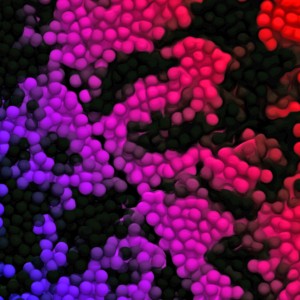A structural approach to relaxation in glassy liquids
D. M. Sussman, & A. J. Liu
As liquids are cooled towards their glass transitions, they exhibit dramatically more sluggish and heterogeneous dynamics. One notorious stumbling block in understanding this behavior has been the inability to identify structural features corresponding to the dynamics. We recently used machine learning methods to construct a structural quantity that correlates strongly with dynamics. We call this quantity “softness”-particles with high softness are highly vulnerable to rearrangement, while those with low softness are resistant. Here we show results from a simulation of a liquid near the glass transition, in which particles with high softness (and corresponding high dynamical mobility) are opaque and colored while particles with low softness are translucent and black. The image was constructed from a two-dimensional slab of the system rendered in POVRAY and then processed with a color gradient.
The paper has been published online in Nature Physics:
http://www.nature.com/nphys/journal/vaop/ncurrent/full/nphys3644.html
Beautiful Science page

